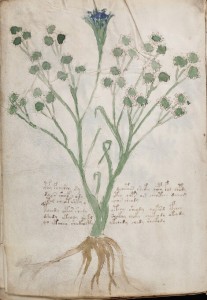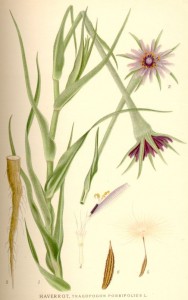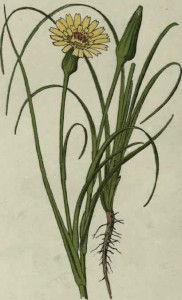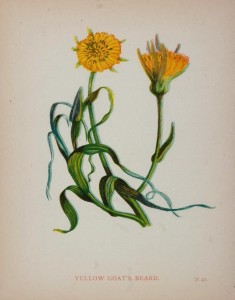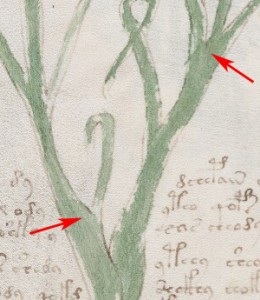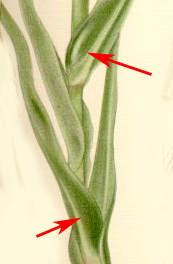Author Archives: J.K. Petersen
Large Plants – Folio 87v
Large Plants – Folio 87r
Large Plants – Folio 66v
Large Plants – Folio 65v
Folio 65v shows a large plant illustration stretching from the bottom edge almost to the top and sides. Text is sparse on this page, comprising less than six full lines, and is broken across the stem of the plant (assuming it’s intended to be read line by line).
Most of the plant is painted green with the exception of the inner flower at the top, which is blue. The smaller flower heads (or seed heads) surrounding it have small petals or other structures, that have been left unpainted. The roots are medium brown.
This page follows another Large Plant page and immediately precedes a page full of text with columns of characters down the left side.
Details
Stems: The stems branch regularly, sometimes opposite, sometimes alternate, becoming thinner near the seed heads (I’m calling them “seed heads” to distinguish them from the larger central head that more nearly resembles a flower head).
Leaves: The leaves are long, narrow, sparse, and some curl back toward the ground.
Flower: The top central structure looks like a flower that is partially emerged or perhaps which doesn’t protrude very far even when in full bloom. It is drawn in green and blue. The green area has spikes that may represent a calyx.
Seed Heads: It’s not certain these are seed heads, but many plants with blossoms will have a rounder look to the head and missing or shriveled petals when they go to seed. The centers have been painted green and the small rounded “petals” or other structures remain unpainted.
Side note about the painting technique: Throughout most of VM 408, it appears that the writer and illustrator (we don’t know for certain they are one and the same, but I suspect they are) preferred to write or paint as much as possible before redipping the pen or brush. Thus, the first few dabs are dark and those following become progressively lighter. Here the seed heads top left are darker green, and the rest become lighter as the pigment is depleted. If the illustrator were right-handed and were concerned about not smearing, then starting top left would be practical. It looks like the brush may have been dipped two or three times to fill in all the seed heads.Roots: The roots are fairly numerous and fairly thick, like multiple tap roots, with fine hairs emanating along their length. They are painted medium brown.
Prior Identification
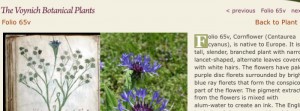 Edith Sherwood has identified this as Centaurea cyanus (cornflower), perhaps because the part that appears to be the flower is painted blue.
Edith Sherwood has identified this as Centaurea cyanus (cornflower), perhaps because the part that appears to be the flower is painted blue.
Other than the color, however, Plant 65v differs from C. cyanus in a number of ways:
- C. cyanus has a rounded, scaly base to the flower head. Plant 65v is more tapered and triangular and lacks the scales.
- C. cyanus spreads out in an umbrella-like fashion from the flower head and each individual petal splits into several pointed tips. Plant 65v barely protrudes and does not have the characteristic parasol shape of the cornflower.
- C. cyanus has more numerous leaves and they do not typically curl like the leaves of 65v. Nearer the base, C. cyanus leaves are larger and have a basal whorl somewhat like a dandelion.
- C. cyanus typically has a single taproot rather than multiple taproots.
- It appears that other plants may be a better match than Centaurea cyanus.
Other Possibilities
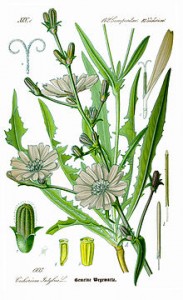 The blue flower and long slender leaves of 65v bring to mind Cichorium intybus (chicory), a salad and forage plant, but chickory leaves are somewhat serrated and they don’t curl in the manner of Plant 65v. C. intybus doesn’t have the scaly round flower head found on C. cyanus, but it does have petals that fan out like a reverse parasol. I don’t think it’s a likely a match for Plant 65v.
The blue flower and long slender leaves of 65v bring to mind Cichorium intybus (chicory), a salad and forage plant, but chickory leaves are somewhat serrated and they don’t curl in the manner of Plant 65v. C. intybus doesn’t have the scaly round flower head found on C. cyanus, but it does have petals that fan out like a reverse parasol. I don’t think it’s a likely a match for Plant 65v.
Scorzonera purpurea or many of the other Scorzoneras might be considered. Many Scorzonera have long narrow leaves that sometimes curl, long calyxes, and one or more tap roots that are sometimes eaten as food. Some Scorzonera have scaly calyxes similar to Centaurea but others (e.g., S. purpurea) have a simple double-layered calyx rather than a complex of scales.
Scorzonera might be a better match than Centaurea, but there are others that come closer.
Tragopogon porrifolius (salsify, oyster plant) is a good candidate for Plant 65v. Various Tragopogon species have blue, purple, pink, or yellow flowers. The calyx of T. porrifolius is triangular and the sepals extend beyond the blossoms, so that the blossoms often have a “tucked in” look. The leaves are long and slender. Tragopogon pratensis (middle) has leaves that curl, as does T. pratensis (right). The long parsnip-like tubers of several species of Tragopogon have a medicinal history and can be eaten boiled or roasted. Sometimes Tragopogon has numerous and surprisingly thick side roots.
But what about all the green and white “puffs” surrounding the blue flower? Later in the year, Tragopogon puts out seed heads that are similar to dandelion puffs, with airy white fluff and a hard center. In some species, the center is white, in others, it is dark. Eventually, the fluff blows away, leaving only the center and a slight fringe of withered sepals. Whether the green and white “knobs” represent seed heads is not clear—it’s something of a stretch. Perhaps this is a representation of the knobs after the seeds have flown or perhaps it’s a different, but related plant.
There is an important detail in Plant 65v that points to Tragopogon as a good candidate. The lower leaves tend to clasp the stem. If you look closely at the Voynich illustration, there are wide spots that look like leaves clasping stems, even if simply and crudely drawn.
Plant 65v may not be Tragopogon, but there’s a good chance that it is and, in terms of flower head, leaf arrangement, stem, and root characteristics, it’s a better candidate than Centaurea cyanus.
Posted by J. Petersen

